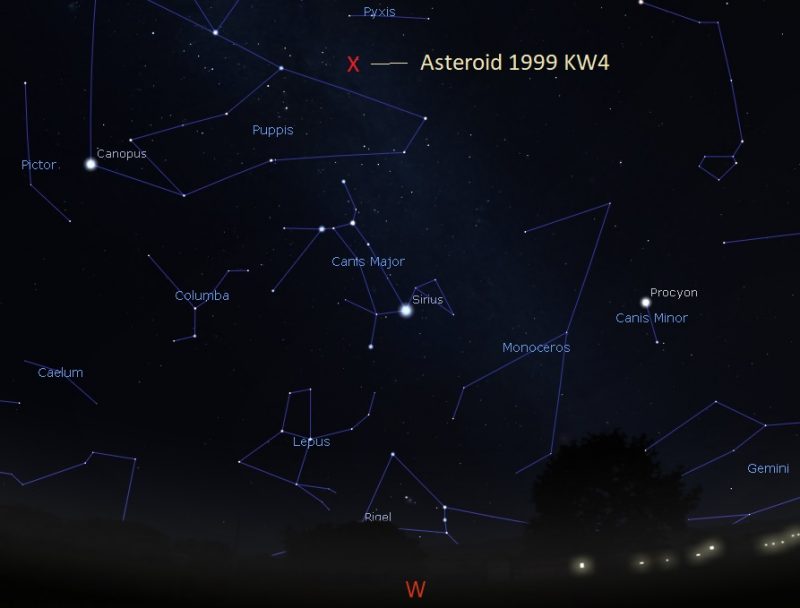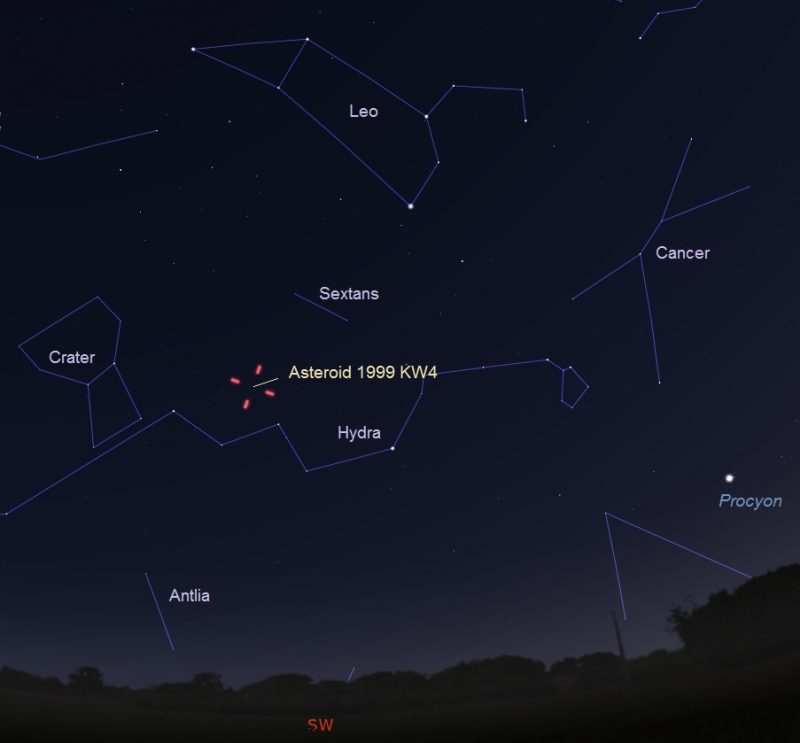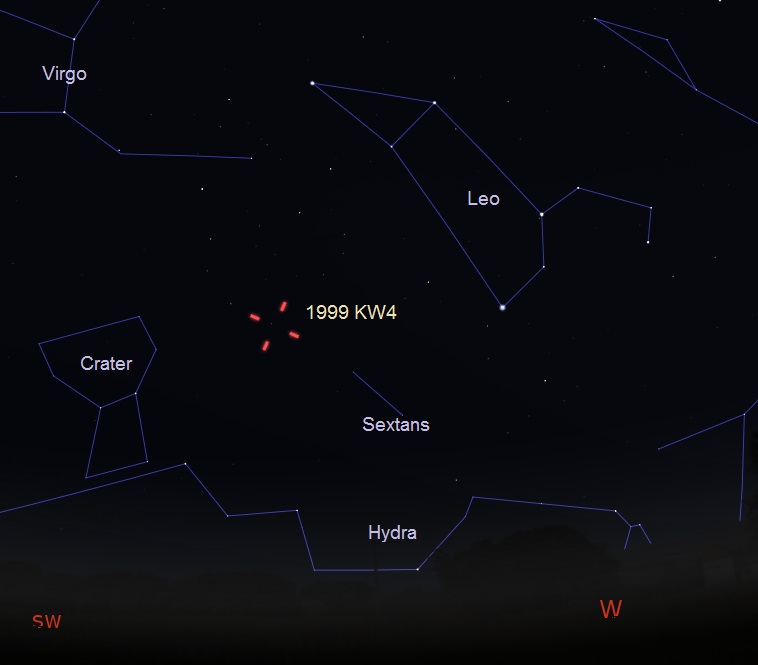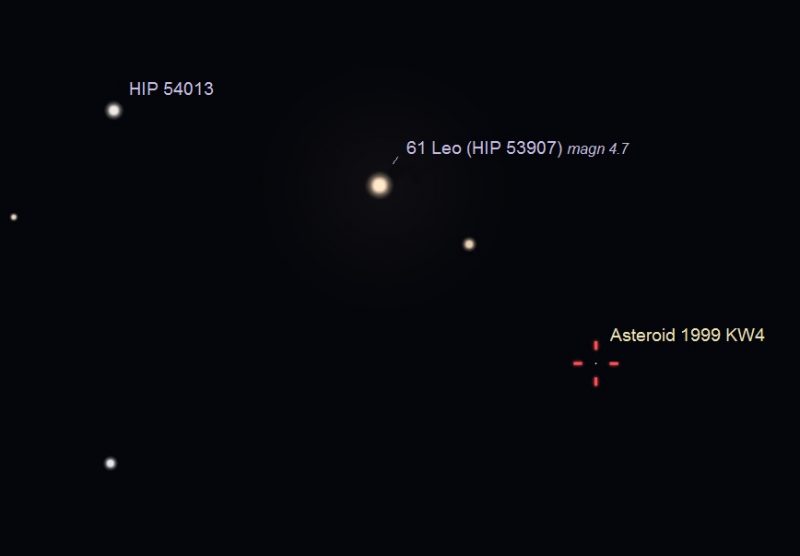
A large double asteroid is now approaching Earth’s vicinity and will pass by Earth safely on May 25, 2019. Closest approach is at 23:05 UTC (7:05 p.m. EDT; translate UTC to your time) on May 25. Asteroid (66391) 1999 KW4 consists of a primary space rock just under a mile wide (about 1.5 km), with a 0.3-mile (0.5-km) companion asteroid – an asteroid moon – orbiting the main asteroid. The asteroid and its moon will provide a good opportunity for both professional and amateur astronomers to observe the huge space rock. Amateur astronomers will be able to observe it for a few days around May 25. See the charts provided at the bottom of this post.
The video above – from a NASA Goldstone Radar planning document – shows the orbital motion of 1999 KW4 from December 2017 until July 2019, in a heliocentric or sun-centered reference frame. The asteroid makes two close flybys of Earth during this period.
1999 KW4 is an Aten type – or Earth-crossing – space rock. Its orbit brings it between the orbits of Venus and Earth. It completes an orbit around the sun once every 6.18 months (188 days).
During the approach of May 25, 2019, the asteroid will pass at the very safe distance of 3,219,955 miles from Earth (5,182,015 km), or about 13.5 times the Earth-moon distance.
Professional astronomers plan to have a look at this asteroid, too. Radar observations of asteroid 1999 KW4 are scheduled from Arecibo Observatory in Puerto Rico from May 29 to June 7. Astronomers will also study asteroid 1999 KW4 using NASA’s Goldstone Solar System Radar, located in the desert near Barstow, California, from May 26 to 31.
An interesting facet of asteroid 1999 KW4 is its shape. It has an oblate shape with an equatorial ridge, similar to asteroids Bennu and Ryugu. Observations suggest the secondary asteroid, or asteroid moon, of 1999 KW4 orbits the main space rock every 16 hours at a distance of about 1.6 miles (2.6 km).

Arecibo radar images of Asteroid 1999 KW4. Image via Arecibo Observatory/NASA/NSF/S. J. Ostro, J. L. Margot, L. A. M. Benner, J. D. Giorgini, D. J. Scheeres, E. G. Fahnestock, S. B. Broschart, J. Bellerose, M. C. Nolan, C. Magri, P. Pravec, P. Scheirich, R. Rose, R. F. Jurgens, E. M. De Jong, S. Suzuki.
1999 KW4 was discovered by the Lincoln Near-Earth Asteroid Research (LINEAR) astronomical survey in Socorro, New Mexico, in 1999. It has been classified as a Near-Earth object and a potentially hazardous object by the Minor Planet Center. However, the orbit of this huge space rock is well understood and known to pose no risk to Earth. During the closest of its approaches to Earth, its orbit brings it no closer than five Earth-moon distances.
The next encounter with Earth, which will be even closer, occurs on May 25, 2036.
An interesting fact: After asteroid 1999 KW4 passes by Earth on May 25, 2019, no known asteroid as big or larger than this space rock will approach our planet this close until year 2027. On June 6, 2027, asteroid 4953 (1990 MU), a 4 km to 9 km (2.5 to 5.5 mi) space rock will safety pass by Earth at 12 lunar distances, and will return on 2058 at nine lunar distances.
Take a look at the curious shape of asteroid 1999 KW4 and its moon in this video:
[youtube https://www.youtube.com/watch?v=mgbRNSHwpZ4?feature=oembed&w=500&h=375]Observing Asteroid 1999 KW4 with amateur telescopes:
1999 KW4 is travelling at 48,123 miles per hour (77,446 km/h or 21.5 km/second), relative to Earth. Its fast speed, combined with the size of this asteroid, will allow amateur astronomers to observe it as it moves in front of the stars! The space rock will not be visible to the eye alone, but sky enthusiasts equipped with 8″ in diameter and bigger telescopes might be able to see this asteroid, which might reach a visual magnitude of around 12 during closest approach.
One the best techniques for locating an asteroid is to point a computerized telescope to a star known to be in the space rock’s path, and wait for the asteroid to appear. It will look like a very slow moving “star.” At first, it may be a little tricky to detect since its motion appears very slow. If you are pointing at the correct time and location of the sky, take a good look at the visual field of the telescope.
Or better yet, draw a sketch of the positions of the brightest stars and a few other stars you see at the eyepiece. Then compare the positions just 10 minutes later, and yes, you will find the asteroid!
By updating your sketches showing the asteroid’s position with respect to the stars, you can also show the huge space rock to other people, so they can see the object that is making news with their own eyes.
Although the location of asteroid 1999 KW4 during closest approach will be most favorable for observers in Earth’s Southern Hemisphere, the space rock will be drifting to other constellations, and observers in the Northern Hemisphere should be able to locate it from May 27, 2019.
During closest approach (May 25), the asteroid will be located in the direction of Puppis, a constellation in the southern sky. On May 26, 2019, the space rock will be located in the constellation Antlia.
The next two charts are for Southern Hemisphere observers, where the view is better on the day of closest approach:

During the asteroid’s closest approach, the space rock will be located in the constellation Puppis, visible with telescopes for observers in the Southern Hemisphere. The asteroid’s location forms an approximate triangle with bright stars Sirius and Canopus. This illustration shows the view facing west from Santiago, Chile, on May 25, 2019, at around 7:30 p.m. (23:30 UTC). Illustration by Eddie Irizarry using Stellarium.

Using computerized amateur telescopes, observers in the Southern Hemisphere can locate the asteroid on the night of its closest approach (May 25) by pointing their instruments to HIP 40945, a faint naked-eye star in the constellation Puppis. Note that the space rock changes its position in just a few minutes! As seen from the Southern Hemisphere on May 25, 2019, at around 23:35 UTC. Illustration by Eddie Irizarry using Stellarium.
Observers in North America and other parts of the Northern Hemisphere will need to wait until a day or two after closest approach, for the asteroid to come over our southern horizons:

Location of asteroid 1999 KW4 on May 27, 2019, at nightfall, as seen from the central U.S., facing southwest. Illustration by Eddie Irizarry using Stellarium.

On May 27, 2019, at around 9:45 p.m. CDT, observers in the U.S. using computerized or Go To telescopes can point their instruments to stars HIP 51053 or HIP 51283 to find asteroid 1999 KW4 slowly moving in front of the stars. Illustration by Eddie Irizarry using Stellarium.

Location of asteroid 1999 KW4 on May 28, 2019, at around 11:00 p.m. – 11:30 p.m. CDT as seen from the central U.S., facing west-southwest. Illustration by Eddie Irizarry using Stellarium.

Have a computerized telescope? Point it to star HIP 53907 (61 Leo) on the night of May 28, 2019, at around 11 – 11:30 p.m. CDT to locate asteroid 1999 KW4. Illustration by Eddie Irizarry using Stellarium.
Go to In-the-Sky.org for more observing information on 1999 KW4
Bottom line: Professional and amateur astronomers are gearing up to observe asteroid 1999 KW4 – a mile-wide, oddly shaped asteroid with a companion moon – around its closest approach on May 25, 2019. Charts here for both Southern Hemisphere and U.S. amateur observers.
Source:
https://earthsky.org/space/double-asteroid-1999-kw4-closest-may-25-2019